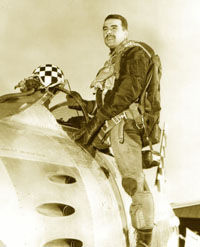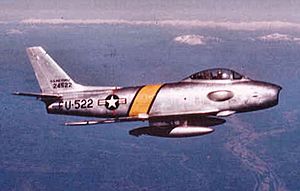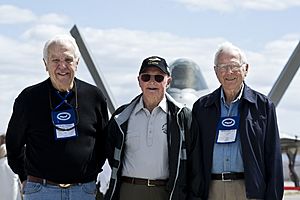Henry Buttelmann facts for kids
Quick facts for kids
Henry Buttelmann
|
|
|---|---|

Buttelmann with his F-86 Sabre in Korea
|
|
| Nickname(s) | Hank |
| Born | June 26, 1929 Corona, New York |
| Died | September 16, 2019 (aged 90) Frankfort, Illinois |
| Buried |
Abraham Lincoln National Cemetery
|
| Allegiance | United States |
| Service/ |
United States Air Force |
| Years of service | 1952–1979 |
| Rank | Lieutenant colonel |
| Unit |
|
| Battles/wars | |
| Awards | Silver Star Distinguished Flying Cross (4) Air Medal (25) |
| Spouse(s) | Audrey Buttelmann |
Henry "Hank" Buttelmann (born June 26, 1929 – died September 16, 2019) was a brave fighter pilot for the United States Air Force. He flew in two big wars: the Korean War and the Vietnam War. During the Korean War, he was amazing at flying his jet and shot down seven enemy planes. This made him a "flying ace", which is a pilot who has shot down five or more enemy aircraft. He became the youngest ace of the Korean War when he got his fifth victory on June 30, 1953, just after his 24th birthday.
Hank Buttelmann was born in Corona, Queens, a part of New York City. He went to the University of Bridgeport for two years. In December 1952, he was sent to Korea. There, he flew an F-86 Sabre jet. He fought against MiG-15 planes in an area called "MiG Alley". This was a dangerous place near the border between North Korea and China. He got his first victory on June 19, 1953, and his fifth just eleven days later. He shot down two more planes in July, shortly before the war ended. Later, he served two times in the Vietnam War. He flew different jets like the F-105 Thunderchief and the F-100 Super Sabre. He retired from the Air Force in 1979. He had flown a total of 286 combat missions during his career.
Contents
Early Life and Training
Henry Buttelmann was born on June 26, 1929. His parents were immigrants from Germany. They lived in Corona, Queens, a neighborhood in New York City. He first became interested in flying because his neighbor was a pilot for American Airlines.
In 1948, he started going to the University of Bridgeport in Connecticut. He also joined the Air National Guard as a private. He had saved money for flying lessons by working as a lifeguard. When the Korean War started in 1950, he was called to serve actively. He went to Big Spring Air Force Base in Texas. After that, he trained for three months at Nellis Air Force Base in Nevada. There, he learned advanced gunnery skills.
Military Career
Flying in the Korean War

In November 1952, Hank joined the 25th Fighter-Interceptor Squadron. This group was part of the 51st Fighter-Interceptor Group. He had to learn how to fight other planes in the air, called air-to-air combat. His earlier training was mostly about shooting at targets on the ground. On December 23, he was sent to Suwon Air Base in South Korea. He flew several practice flights in the F-86 Sabre jet. His first real combat mission was on January 15, 1953.
He flew in a famous area known as "MiG Alley". This was a nickname for the skies near the border between North Korea and China, close to the Yalu River. American pilots often fought against Chinese, Soviet, and North Korean MiG-15 planes there. By the time Buttelmann arrived, the war was slowing down. There were not many enemy planes in the sky. Because of this, he flew very boldly. He even went north of the Yalu River, into Chinese territory. But he still only saw enemy MiGs twice in his first five months. During this time, he was a "wingman", which means he flew alongside another pilot.
On his 50th mission, he saw a group of MiGs. But he had to leave the fight because his fuel was too low to get back to base safely. When he returned, the airport was covered in clouds. Buttelmann said he was very lucky to land safely with so little fuel.
On June 19, which was his 55th mission, he was leading his group for the first time. This meant he was in a position to shoot. On this day, he got his very first enemy plane.
His fifth victory happened on June 30, 1953. This made him a "flying ace". He was the 36th ace for the U.S. Air Force. At 24 years and 4 days old, he was also the youngest ace of the war.
On July 19, he was flying with three other F-86s. Their leader was John Glenn, who later became a famous astronaut. They met a group of MiGs. In the fight, Glenn, Buttelmann, and Glenn's wingman each shot down an enemy plane. Glenn later said that the MiGs' flying was so bad, it seemed like they were just on a training flight. Three days later, on another flight with Glenn, Buttelmann got his seventh and final victory. This was also the last day of air combat in the war. After flying 65 combat missions in Korea, Buttelmann went back to Nellis Air Force Base to teach other pilots.
Service in the Vietnam War
Buttelmann was at McConnell Air Force Base in Kansas. In April 1965, he was sent to Takhli Royal Thai Air Force Base in Thailand. This was after the Vietnam War had started. He was part of the 562d Tactical Fighter Squadron. He flew 46 missions in the F-105 Thunderchief during his four months there. In May 1969, he went back for a second tour of duty that lasted twelve months. He flew 232 combat missions in the F-100 Super Sabre. During this time, he commanded the Misty Forward Air Controllers and the 308th Tactical Fighter Squadron.
He retired from the Air Force in October 1979. His final rank was lieutenant colonel. He had flown a total of 286 combat missions in both wars.
Later Life

In May 2015, he received the Congressional Gold Medal. This special award was given to him by Nevada Senator Dean Heller. It honored his role as an American Fighter Ace during the Korean and Vietnam Wars.
Henry Buttelmann passed away on September 16, 2019, at 90 years old. He died in Frankfort, Illinois. He and his wife, Audrey Buttelmann, had moved there in 2018. When he died, Buttelmann was one of only two Korean War aces still alive. The other was Charles G. Cleveland. Buttelmann was buried at Abraham Lincoln National Cemetery.
Awards and Honors
Henry Buttelmann received many awards for his bravery and service. Some of his most important decorations include:
- Silver Star
- Distinguished Flying Cross (four times)
- Air Medal (twenty-five times)
- Air Force Commendation Medal
- National Defense Service Medal
- Korean Service Medal
- Vietnam Service Medal
- Air Force Longevity Service Award
- Republic of Korea Presidential Unit Citation
- Republic of Vietnam Gallantry Cross
- United Nations Service Medal for Korea
- Vietnam Campaign Medal
- Korean War Service Medal
See also
- List of Korean War flying aces

